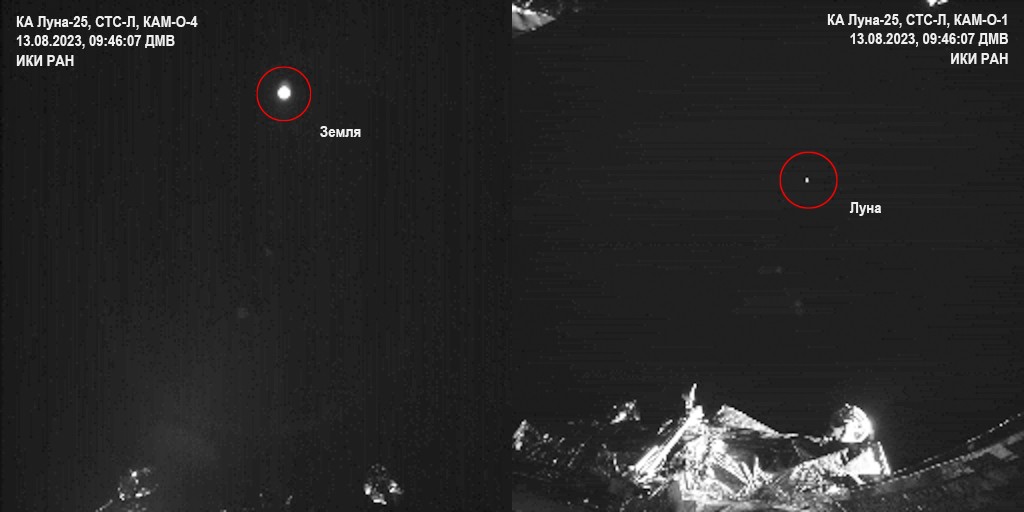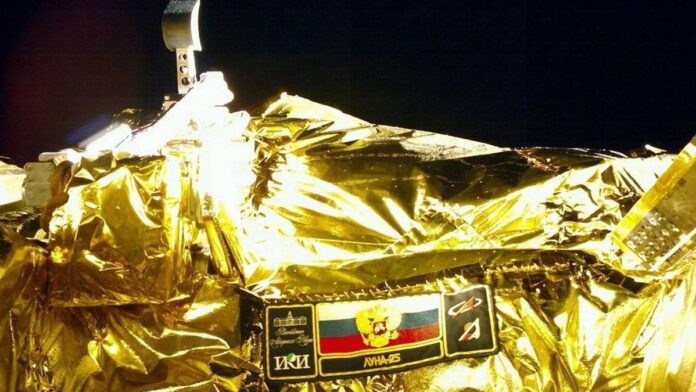Russia’s revamping of moon exploration is off to a rocky start.
The country’s Luna-25 spacecraft plunged from lunar orbit on Saturday (Aug. 19), destroying itself as it crashed into the moon’s bleak landscape.
Yuri Borisov, head of the Russia space agency Roscosmos, reported that the main cause of the Luna-25 crash was an anomalous engine burn. Instead of a planned propulsive nudge of 84 seconds, the engine operated for 127 seconds, more than the “required value” in readying the probe for its descent burn. This added impulse caused Luna-25 to smash into the moon, Borisov told Rossiya 24 television.
Related: Russia launches Luna-25 moon lander, its 1st lunar probe in 47 years
Modern Russia’s 1st moon mission
Following its Aug. 10 liftoff, Luna-25 successfully switched on its scientific equipment. All systems on the spacecraft were working normally in the days after launch, according to Roscosmos.
The probe reached lunar orbit on Aug. 16 and was gearing up to land near the moon’s south pole as early as Monday (Aug. 21). Its primary landing site was near Boguslawsky Crater, though two backup touchdown spots were also in play: southwest of Manzini Crater and south of Pentland A Crater.
Designed, built and tested by the Russian aerospace company NPO Lavochkin, Luna-25 was to work on the lunar surface for at least one Earth year.
Luna-25’s Aug. 10 launch from the Vostochny spaceport picked up where the former Soviet Union’s moon-probing projects left off. The final Soviet moon mission, Luna-24, successfully hauled home to Earth about 6 ounces (170 grams) of lunar samples in 1976.
Heralded as the first domestically produced moon probe in modern Russia history, Luna-25’s flight was important in both political and scientific terms. The implications of its failure are likely to be considerable.
Low point
Following the Luna-25 crash, Russia quickly appointed an investigatory committee.
“We should expect an initial report in weeks. The immediate cause seems, in general, to be clear enough,” said Brian Harvey, an author and space historian in Ireland with a keen eye on Soviet and Russian space exploits.
“The Luna-25 engine fired for 50 percent longer than planned,” Harvey told Inside Outer Space. That made the probe’s orbital low point not the intended 11 miles (18 kilometers) but far below surface level — a “minus” 9 miles (15 km).
Space expert Bob Christy of the website OrbitalFocus explained that Luna-25’s orbit over the weekend was around 62 miles (100 km) circular at 87 degrees inclination.
A thruster firing by the moon-circling craft was set to lower it to 10 miles by 62 miles (16 by 100 km), and the next phase would have been the landing burn to put it down on the surface from 10 miles up. The inclination, he said, allowed Luna-25 to pass over the polar target area.
“The perigee-lowering burn went on for too long, either through failing to shut down or through the engineers programming it wrongly,” Christy told Inside Outer Space. “It would have resulted in perigee below ground level. The time of signal loss probably marks when it hit the surface.”
Luna-25 succeeded in reaching an orbit of 10 miles x 68 miles (16 by 110 km), from where it started descent. But transmissions reportedly ceased about 1.9 miles (3 km) up, said Christy.
“Whether it hit a mountain or simply failed at that point is moot because, in the latter case, it would have hit the ground at its target point anyway,” Christy observed.
“The deeper causes will take more unraveling,” Harvey added. “The crash came not at the most risky point of the mission — the final stages of the descent to the surface — but during what should have been a routine firing to lower the orbit before the final descent.”
Unless it was purely an engine anomaly, Harvey added that it seems this failure is yet another landing attempt doomed by issues with computer guidance and/or engine control issues.
Related: Missions to the moon: Past, present and future

Automated descents
Harvey pointed to the moon-landing failures of Beresheet (operated by a private Israeli group), Chandrayaan-2 (India) and Hakuto R (the Japanese company ispace), as well as the failed Mars landing of Europe’s Schiaparelli craft.
“Ironically, the Soviet Union pioneered successful automated descents from lunar orbit using radar and pre-digital control and guidance,” Harvey said, citing the Luna-16, 17, 20, 21 and 24 missions.
“Only China has a clean sheet in computer guidance and engine control descent from lunar orbit. For everyone else, it’s hard. Ironically, too, Russian quality control has improved greatly in recent years, but people will remember this exception,” Harvey said.
As for the Luna-25 failure, “Russia was probably starting from scratch in planning and executing this mission, as its experienced engineers from the 1970s had long passed retirement age. It wasn’t a simple evolution of the previous lunar mission,” Christy said.
China’s confidence
According to Harvey, the traditional reaction to a serious failure in the Russian and Soviet space program has been a punitive “heads-will-roll” approach and less funding.
This time, though, that is unlikely to help Russia maintain a lunar program (Luna-26, 27) to match its partner China’s (Chang’e 6, 7, 8), Harvey said. (Russia is working with China on the International Lunar Research Station, a moon base targeted to be up and running by the mid- to late 2030s.)
“Chinese lunar engineers attended the Luna-25 launch at Vostochny for the first time, a short distance to travel geographically but a longer one politically, and Russia must recover China’s confidence,” Harvey said.
It is not known if there is a Luna-25 backup or if a replacement can be constructed, Harvey added. But waiting several years for Luna-26 will not encourage China.
Deeper causes
“Although sanctions on computer parts and a limited tracking system have been blamed for the failure, these are insufficient explanations,” said Harvey. “The Soviet Union ran a successful lunar program from 1959 to 1976 despite a sanctions wall and with limited tracking networks.”
The deeper causes of the Luna-25 failure, Harvey continued, go back to the 1990s, a period of “chaos capitalism” when the whole space program almost collapsed.
“Russian space spending now lags far behind the U.S., China, Europe and even Japan,” he said. Space science suffered the most, he said, exemplified by the failed Roscosmos-operated Mars 96 (sometimes called Mars-8) mission, “completed by candlelight in an unheated hangar in winter.”
Related: The latest news about China’s space program
Underfunding
Apart from two successful observatories, Spektr R and Spektr RG, there have been hardly any Russian scientific space missions, Harvey said. Experience in running such complex missions is low, he added.
Before contact and cooperation with Russia were cut off, European visitors to Moscow contrasted the situation of the Lavochkin design bureau with the more generously funded human spaceflight program run by the Energiya and Progress design bureaus — possibly rightly so, given that human lives are at stake, Harvey pointed out.
“By contrast, meetings with Lavochkin took place not in the bureau but in adjacent hotels, not, it seemed because of secrecy but because under-investment in the science program would be so obvious,” Harvey said. “Underfunding may be the real root of what went wrong.”

